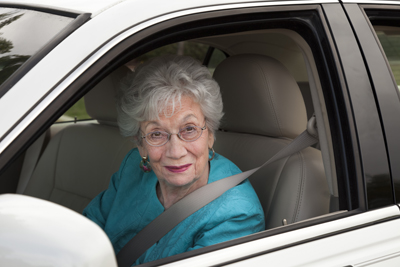I Have Cataracts—Can I Drive?

June Is Cataract Awareness Month, a great time to get an eye exam. During the exam, your doctor will check for the presence of cataracts, which are caused by the clouding of the lens of the eye. Cataracts cause dull, blurry vision and make it harder to take part in normal, daily activities.
The bad news is that cataracts are very common among older adults. But there’s good news: cataracts are very treatable. A simple, safe surgery can markedly improve a senior’s sight. Today, this is the most often-performed surgery in America, and that’s paying off in senior health. A recent study from Harvard Medical School even reported that cataract surgery has increased our life expectancy, right along with medical advances in cardiac care!
Before older adults undergo cataract surgery, they—and their families—might wonder if it’s safe for them to drive. The National Highway Traffic Safety Administration (NHTSA) offers this information:
Be alert for signs of cataracts which might make it dangerous to drive:
- Difficulty seeing at dawn, dusk, and at night
- Sunlight seems too bright
- Night driving is harder due to glare from car headlights
- Colors look faded
- You might see double images with the affected eye
If you notice these symptoms, see your eye health care provider right away. Your doctor may recommend surgery, and you may also be referred to a specialist who can help:
- A driver rehabilitation specialist can test how well you drive on and off the road. This specialist also may offer training to help improve your driving skills, and keep you and others safe on the road. To find a driver rehabilitation specialist, visit the website of the American Occupational Therapy Association.
- An occupational therapist with special training can provide driving skills assessment and remediation. To find an occupational therapist, contact local hospitals and rehabilitation centers.
Can I still drive with a cataract?
If your doctor has told you that you have a cataract, there are certain things that you should know and do to remain a safe driver. The NHTSA says:
Every person’s cataract is different. In its early stages, your cataract may be so small that it does not affect your vision. You may be able to drive safely for many years if you have no other serious medical problems. However, over time the cataract may worsen and cloud more of
the lens of your eye.
It may become difficult to see and to drive safely if you have a cataract. You may need to plan car trips to avoid times when vision may be most affected—for example, driving west at dusk into a setting sun or during rainy conditions at night. Clean your car windshields (both inside and outside) often so vision is not reduced even further. You also should clean your automobile headlights to provide as much light as possible for night driving.
What if I can’t drive?
Giving up driving doesn’t mean giving up mobility. Learn about alternate transportation in your area, such as the bus or rapid transit, taxi cabs or ridesharing services. If you think you only need a short-term solution until you have cataract surgery, family and friends also may be happy to give you a lift.
Source: IlluminAge AgeWise with information from the National Highway Traffic Safety Administration (NHTSA). Visit the NHTSA website to learn more about safe driving for older adults.
![Health Concepts [logo]](https://healthconceptsltd.com/wp-content/themes/healthconcepts-corporate/images/logo.png)
